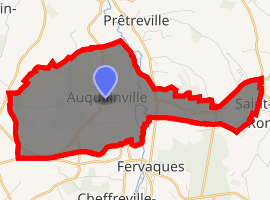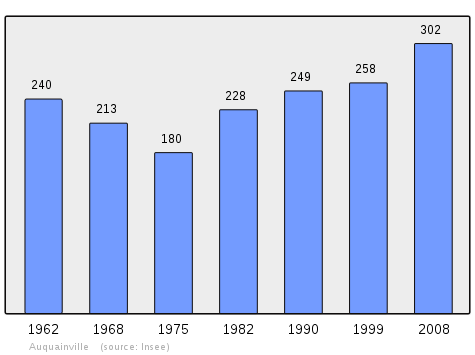Auquainville
Auquainville is a former commune in the Calvados department in the Normandy region of north-western France. On 1 January 2016, it was merged into the new commune of Livarot-Pays-d'Auge.[2]
Auquainville | |
|---|---|
Part of Livarot-Pays-d'Auge | |
The centre of Auquainville | |
Location of Auquainville 
| |
 Auquainville  Auquainville | |
| Coordinates: 49°03′27″N 0°14′24″E | |
| Country | France |
| Region | Normandy |
| Department | Calvados |
| Arrondissement | Lisieux |
| Canton | Livarot |
| Commune | Livarot-Pays-d'Auge |
| Area 1 | 9.56 km2 (3.69 sq mi) |
| Population (2017)[1] | 298 |
| • Density | 31/km2 (81/sq mi) |
| Time zone | UTC+01:00 (CET) |
| • Summer (DST) | UTC+02:00 (CEST) |
| Postal code | 14140 |
| Elevation | 67–184 m (220–604 ft) (avg. 250 m or 820 ft) |
| 1 French Land Register data, which excludes lakes, ponds, glaciers > 1 km2 (0.386 sq mi or 247 acres) and river estuaries. | |
The inhabitants of the commune are known as Auquainvillais or Auquainvillaises.[3]
Geography
Auquainville is located some 10 km south of Lisieux and 13 km west by north-west of Orbec. Access to the commune is by the D149 road which comes from Saint-Martin-de-Mailloc in the north-east and passes south through the commune and the village continuing to Livarot in the south-west. The D64 road comes from Saint-Martin-de-la-Lieue in the north and passes south through the east of the commune to Fervaques. The D135B branches east off the D64 in the commune and joins the D135 just east of the commune. Apart from the village, there are the hamlets of La Blondeliere in the west with Le Mollants and Le Maubuisson in the east. The commune is mixed forest and farmland with a particularly large forest to the west of the village (the Bois des Grandes Ventes).[4]
The Touques river passes through the commune from south to north just east of the village and continues north to join the ocean at Trouville-sur-Mer. The Ruisseau de la Marette rises in the commune and flows east into the Touques.[4]
History
In 1831 Auquainville with 456 inhabitants merged with Saint-Aubin-sur-Aquainville with 91 inhabitants which was in the south of the territory.
Administration
List of Successive Mayors[5]
| From | To | Name | Party | Position |
|---|---|---|---|---|
| 1983 | 2014 | Raymond Géret | Farmer | |
| 2014 | 2020 | Philippe Soetaert |
(Not all data is known)
Demography
In 2010 the commune had 307 inhabitants. The evolution of the number of inhabitants is known from the population censuses conducted in the commune since 1793. From the 21st century, a census of communes with fewer than 10,000 inhabitants is held every five years, unlike larger towns that have a sample survey every year.[Note 1]
| 1793 | 1800 | 1806 | 1821 | 1831 | 1836 | 1841 | 1846 | 1851 |
|---|---|---|---|---|---|---|---|---|
| 578 | 507 | 639 | 507 | 456 | 500 | 452 | 454 | 393 |
| 1856 | 1861 | 1866 | 1872 | 1876 | 1881 | 1886 | 1891 | 1896 |
|---|---|---|---|---|---|---|---|---|
| 374 | 371 | 421 | 388 | 367 | 284 | 330 | 287 | 245 |
| 1901 | 1906 | 1911 | 1921 | 1926 | 1931 | 1936 | 1946 | 1954 |
|---|---|---|---|---|---|---|---|---|
| 247 | 265 | 239 | 216 | 225 | 207 | 204 | 262 | 223 |
| 1962 | 1968 | 1975 | 1982 | 1990 | 1999 | 2006 | 2010 | - |
|---|---|---|---|---|---|---|---|---|
| 240 | 213 | 180 | 228 | 249 | 258 | 293 | 307 | - |

Culture and heritage
Civil heritage
The commune has a number of buildings and structures that are registered as historical monuments:
Religious heritage
.jpg)
The commune has several religious buildings and structures that are registered as historical monuments:
- The Church of Saint Aubin (15th century).

- The Church of Notre-Dame (15th century).

- A Retable (17th century)

- A Group Sculpture: Education of the Virgin (17th century)

- A Retable (17th century)

- A Painting: The Annunciation (17th century)

- A Retable (17th century)

- A Tabernacle (17th century)

- A fragment of Stained glass (16th century)

- A Painting: The placing in the tomb (17th century)

- A Painting: The martyrdom of Saint Ursula (17th century)

- An Altar (17th century)

- An Altar (17th century)

- The Altar facing (17th century)

- The Altar wood carving of the Annunciation (17th century)

- A Retable (17th century)
- The Church of Saint Pierre has a number of items that are registered as historical objects:
Notable people linked to the commune
- Astolphe Louis Léonor, Marquis de Custine (1790-1857), writer, is buried in the Chapel of Saint-Aubin-sur-Auquainville.
See also
External links
- Auquaniville on the 1750 Cassini Map (N.B. Misspelt on the map)
Notes and references
Notes
- At the beginning of the 21st century, the methods of identification have been modified by Law No. 2002-276 of 27 February 2002 Archived 6 March 2016 at the Wayback Machine, the so-called "law of local democracy" and in particular Title V "census operations" allows, after a transitional period running from 2004 to 2008, the annual publication of the legal population of the different French administrative districts. For communes with a population greater than 10,000 inhabitants, a sample survey is conducted annually, the entire territory of these communes is taken into account at the end of the period of five years. The first "legal population" after 1999 under this new law came into force on 1 January 2009 and was based on the census of 2006.
References
- Téléchargement du fichier d'ensemble des populations légales en 2017, INSEE
- Arrêté préfectoral 24 December 2015 (in French)
- Inhabitants of Calvados (in French)
- Google Maps
- List of Mayors of France (in French)
- Ministry of Culture, Mérimée PA00111022 Lortier Manor (in French)
- Ministry of Culture, Mérimée PA00111021 Caudemone Manor (in French)

- Ministry of Culture, Mérimée IA14000757 Mill for Fullers Earth (in French)

- Ministry of Culture, Mérimée PA14000075 Church of Saint Aubin (in French)
- Ministry of Culture, Palissy PM14001194 Main Altar, seating, Tabernacle urn, Retable, an Altar Painting: the Agony of Christ in the garden of olives, and 2 Statues of St. Aubin and St. Sebastian (in French)

- Ministry of Culture, Palissy PM14001195 Secondary Altar, seating, Retables, and 2 Statues of the Virgin and St. Quentin (in French)

- Ministry of Culture, Mérimée PA00111020 Church (in French)

- Ministry of Culture, Palissy PM14000957 Retable (in French)
- Ministry of Culture, Palissy PM14000956 Group Sculpture: Education of the Virgin (in French)
- Ministry of Culture, Palissy PM14000955 Retable (in French)
- Ministry of Culture, Palissy PM14000954 Painting: The Annunciation (in French)
- Ministry of Culture, Palissy PM14000953 Retable (in French)
- Ministry of Culture, Palissy PM14000952 Tabernacle (in French)
- Ministry of Culture, Palissy PM14000022 Fragment of Stained glass (in French)
- Ministry of Culture, Palissy PM14000021 Painting: The placing in the tomb (in French)
- Ministry of Culture, Palissy PM14000020 Painting: The martyrdom of Saint Ursula (in French)
- Ministry of Culture, Palissy PM14000019 Altar (in French)

- Ministry of Culture, Palissy PM14000018 Altar (in French)

- Ministry of Culture, Palissy PM14000017 Altar facing (in French)

- Ministry of Culture, Palissy PM14000016 Altar wood carving of the Annunciation (in French)

- Ministry of Culture, Palissy IM14005204 Stained glass window with a lady's head (in French)

- Ministry of Culture, Palissy IM14005203 Decorative stained glass (in French)
- Ministry of Culture, Palissy IM14005202 2 Stained glass windows: St. John and St. Mark and St. Matthew and St. Luke (in French)

| Wikimedia Commons has media related to Auquainville. |
.jpg)
.jpg)